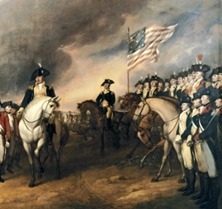WAR: 1775-1783

The American Revolution was a hard-fought war between scrappy volunteer soldiers and the professional army of an imperial power. Which side would you have picked as the likely winner? In this Theme we view the Americans' victory as a process, not answering how they won the war but exploring what they confronted, endured, and overcame to win the war. The nine sections focus on anticipating the war (and trying to avoid it), committing to one side or the other, leading the troops, sustaining the war effort, reporting its progress, fighting as soldiers and sailors, living as civilians during wartime, losing the war (the British, of course), and winning the war (those scrappy volunteer soldiers led by the resolute George Washington).
Sections in WAR
Each section presents primary resources, introductory notes, classroom discussion questions, and supplemental links.
- Anticipating War
- - Edmund Burke, speech to Parliament on reconciliation with America, 1775, selections
- - Benjamin Franklin, letters on the prospects of reconciliation and the beginning of war, 1775-1776, selections
- Committing to War
- - A Loyalist's address to the American soldiers: Peter Oliver, letter to the Massachusetts Gazette, January 1776, selections
- - A Patriot's address to the American soldiers: Thomas Paine, The American Crisis, #1, December 1776
- Leading the War
- - Correspondence of George Washington as Commander in Chief, 1775-1778, selections
- - Portraits (3) of George Washington as Commander in Chief, 1779, 1780, 1785
- - Military broadsides of the Revolution (9), 1775-1778
- Sustaining the War
- - Pacifying Indians on the frontier: three documents, 1776-1778, excerpts
- - Recruiting enslaved blacks into the army: six documents, 1776-1781, excerpts
- - Predicting Britain's response to the U.S. alliance with France: letters of Benjamin Franklin and the American negotiators, 1778
- - Requesting state aid for the army: Washington's appeal to the governor of Pennsylvania, 1780
- - Announcing the treason of Benedict Arnold: Washington's statement to the Continental Army, 1780
- Reporting the War
- - Broadsides (7) reporting news of the war, 1776-1783
- - Broadside on a parade condemning the treason of Benedict Arnold, 1780
- Fighting the War
- - Pension narratives of Revolutionary War veterans, 1830s, selections
- - Philip Freneau, The British Prison Ship, poem, 1781, selection
- - Boyrereau Brinch, enslaved black soldier in the American army, narrative selections
- - Boston King, fugitive slave in the British army, narrative selections
- Living the War
- - Margaret Hill Morris, Quaker widow in New Jersey, journal selections, 1776-1777
- - Molly Gutridge, Massachusetts, "A New Touch of the Times," poem, 1779
- - Mary Jemison (Dehgewanus), white Seneca adoptee in New York, narrative selections, 1779-1780
- - Eliza Yonge Wilkinson, planter's daughter in South Carolina, letter selections, 1780
- - Esther De Berdt Reed, Sentiments of an American Woman, broadside, 1780
- - Anna Rawle, Loyalist's daughter in Philadelphia, journal selections, 1781
- Losing the War
- - British satirical rebuses (2) on the U.S. alliance with France, 1778
- - British cartoons (4) on Britain's defeat in the war, 1782
- - Loyalists and the defeat of Britain: selections from letters, narratives, petitions, and poetry, 1782-1786
- Winning the War
- - Governors' appeals for citizen unity in the war effort, 1780-1781, selections
- - Satirical epitaph for King George III after the defeat of Britain, broadside, 1782
- - Benjamin Franklin, letters from Paris on the peace process, 1781-1784
- - Maps
- 1783: The United States of America (Sayer)
- 1784: Bowles's New Pocket Map of the United States of America
Framing Questions
- How did Patriot leadership—military, diplomatic, and governmental—promote and hinder the war effort?
- How did the war affect Patriots, Loyalists, Indians, African Americans, and women? How were power relationships changed?
- How were decisions by Britain and France critical to the outcome of the war?
- Was victory the last achievement of the thirteen colonies or the first achievement of the new nation?
Image: John Trumbull, Surrender of Lord Cornwallis, oil on canvas, 1820 (detail). Courtesy of the U.S. Capitol, Office of the Architect of the Capitol.



